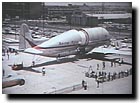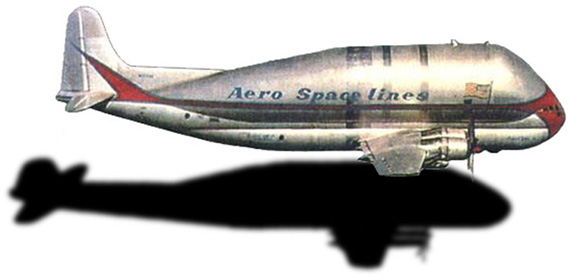
Drawings
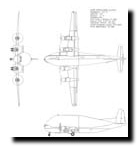 The Pregnant Guppy was the first of a unique family of aircraft
that have been transporting outsized cargo for almost 40 years. Their loads
were cargo that either couldn't be transported any other way, or only with
great time and trouble.
The Pregnant Guppy was the first of a unique family of aircraft
that have been transporting outsized cargo for almost 40 years. Their loads
were cargo that either couldn't be transported any other way, or only with
great time and trouble.The Pregnant Guppy had humble beginning on the proverbial cocktail napkin. One evening friends Jack Conroy, Lee Mansdorf and others were were discussing the problems NASA was having transporting the rocket booster stages aboard ships through the Gulf of Mexico. Mansdorf had recently purchased several surplus Boeing Stratocruisers but wasn't really sure what to do with them. Conroy figured they could take one of the Stratocruisers, enlarge the fuselage big enough to hold a rocket booster and contract with NASA to fly the boosters from California to Florida.
The napkins were flying that night! Some of the ideas discussed included having the top of the fuselage hinge open. The cargo would then be lowered in with a crane. This idea was scrapped early on for obvious reasons.
(30K JPG image)
Pictures
 The first flight of Boeing B-377 NX1024V (c/n 15924), the third
Stratocruiser prototype, took place on October 7th, 1948. Although painted
in Pan American colors and named Clipper America, it was used by Boeing
for testing. It was the 2nd Clipper America actually, the first Clipper
America used for Pan American inaugural flights was the second Stratocruiser
prototype, NX1023V (c/n 15923), later renamed Clipper Golden Gate.
The first flight of Boeing B-377 NX1024V (c/n 15924), the third
Stratocruiser prototype, took place on October 7th, 1948. Although painted
in Pan American colors and named Clipper America, it was used by Boeing
for testing. It was the 2nd Clipper America actually, the first Clipper
America used for Pan American inaugural flights was the second Stratocruiser
prototype, NX1023V (c/n 15923), later renamed Clipper Golden Gate.(46K JPG image)
 Boeing delivered NX1024V to Pan American as Clipper Bald Eagle
N1024V on June 12th, 1949. Later refitted as a Super Stratocruiser and used
for the Pacific routes, Pan American renamed N1024V Clipper Cathay. It was
stored at Miami in 1960. Then traded to Boeing in 1961, sold to Mansdorf,
then to Aero Spacelines.
Boeing delivered NX1024V to Pan American as Clipper Bald Eagle
N1024V on June 12th, 1949. Later refitted as a Super Stratocruiser and used
for the Pacific routes, Pan American renamed N1024V Clipper Cathay. It was
stored at Miami in 1960. Then traded to Boeing in 1961, sold to Mansdorf,
then to Aero Spacelines.(41K JPG image)
 The Pregnant Guppy was constructed using B-377 N1024V and parts
of B-377 (c/n 15976). The construction was done in three main phases. First,
Aero Spacelines had to lengthen the fuselage enough fit the 40 ft. long
Saturn S-IV stage. This was done by adding a 16 ft. 8 in. section of fuselage
from a second Stratocruiser immediately aft of the wing's trailing edge.
After adjusting the controls for the relocated center of gravity, they were
able to move onto phase two.
The Pregnant Guppy was constructed using B-377 N1024V and parts
of B-377 (c/n 15976). The construction was done in three main phases. First,
Aero Spacelines had to lengthen the fuselage enough fit the 40 ft. long
Saturn S-IV stage. This was done by adding a 16 ft. 8 in. section of fuselage
from a second Stratocruiser immediately aft of the wing's trailing edge.
After adjusting the controls for the relocated center of gravity, they were
able to move onto phase two. (34K JPG image)
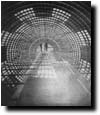
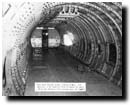 This phase called for a massive enlargement of the entire upper
cabin section. In order to accommodate the 18 ft. cross section of the S-IV
stage, the fuselage would have to be enlarged to over 19 ft. in diameter
to give enough clearance for proper loading of the cargo. The original fuselage
was left in place for now, with the extended fuselage braced up with 2x4
lumber!
This phase called for a massive enlargement of the entire upper
cabin section. In order to accommodate the 18 ft. cross section of the S-IV
stage, the fuselage would have to be enlarged to over 19 ft. in diameter
to give enough clearance for proper loading of the cargo. The original fuselage
was left in place for now, with the extended fuselage braced up with 2x4
lumber! (48K & 53K JPG images)
 The Pregnant Guppy first flew with the extended fuselage on top
of the original, on September 19th, 1962. Jack was the test pilot with Clay
Lacy in the right seat. The next day September 20, out of cash and in need
of a more firm commitment from NASA about the contract for the Guppy program,
Jack headed east with the Pregnant Guppy on a demonstration tour.
The Pregnant Guppy first flew with the extended fuselage on top
of the original, on September 19th, 1962. Jack was the test pilot with Clay
Lacy in the right seat. The next day September 20, out of cash and in need
of a more firm commitment from NASA about the contract for the Guppy program,
Jack headed east with the Pregnant Guppy on a demonstration tour. (35K JPG image)
 With special permission from the FAA so long as he avoided major
population centers, he headed for Las Vegas for the Air Force Association
convention. Then on to Oklahoma City, Tulsa, and then to NASA's Manned Space
Center in Houston. Then Conroy with his adventuresome crew set their sites
for the Marshall Space Flight Center at Huntsville. A mixed group of skeptics
and enthusiasts turned out to see the Guppy including the Director of MSFC,
Werner von Braun. Conroy's dash had long appealed to von Braun, and now
von Braun was delighted.
With special permission from the FAA so long as he avoided major
population centers, he headed for Las Vegas for the Air Force Association
convention. Then on to Oklahoma City, Tulsa, and then to NASA's Manned Space
Center in Houston. Then Conroy with his adventuresome crew set their sites
for the Marshall Space Flight Center at Huntsville. A mixed group of skeptics
and enthusiasts turned out to see the Guppy including the Director of MSFC,
Werner von Braun. Conroy's dash had long appealed to von Braun, and now
von Braun was delighted. (30K JPG image)
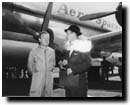 Most of the people seemed pretty doubtful of the Guppy's potential.
Some high-ranking people stood and shook their heads and said, "There is
no way that airplane is going to fly". Some expressed concern about the
method of attaching the rear of the fuselage with bolts. Jack, seen here
on the left, told them that the mechanic that had "torqued" the bolts was
also required to go on the flight. This seemed to ease some of their anxiety,
Conroy wryly noted later.
Most of the people seemed pretty doubtful of the Guppy's potential.
Some high-ranking people stood and shook their heads and said, "There is
no way that airplane is going to fly". Some expressed concern about the
method of attaching the rear of the fuselage with bolts. Jack, seen here
on the left, told them that the mechanic that had "torqued" the bolts was
also required to go on the flight. This seemed to ease some of their anxiety,
Conroy wryly noted later.(32K JPG image)
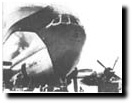 Jack needed to pull off a convincing test of the Guppy's ability.
Without enough time to load sufficient ballast in sand bags, a full load
of fuel was put on to give the needed additional weight. Herman Kroeger,
a long time member of von Braun's group and former test pilot, and Julian
Hamliton, a key Saturn logistics program manager went up for the first flight
as official MSFC observers.
Jack needed to pull off a convincing test of the Guppy's ability.
Without enough time to load sufficient ballast in sand bags, a full load
of fuel was put on to give the needed additional weight. Herman Kroeger,
a long time member of von Braun's group and former test pilot, and Julian
Hamliton, a key Saturn logistics program manager went up for the first flight
as official MSFC observers. Kroeger was so excited after the flight about the Pregnant Guppy's abilities, he lapsed into German when describing it to his colleagues. von Braun was so interested, he wanted to go up for a flight. To the dismay of many present, he crawled aboard the Guppy and took off in it. For the second time Jack demonstrated the airplane's ability to maintain course and altitude with engines Nos. 1 and 2 out, with only light control input. von Braun was sold. Informal contract talks began that day.
(26K JPG image)
 Satisfied that the Guppy could fly, Conroy gave the go-ahead for
workmen to cut away the inner fuselage and mate the extended outer fuselage
to the airframe as a load-bearing member. The only other change to the basic
structure was the addition of the dorsal fin for added stability in flight.
It was about this time that airplane was officially dubbed "Pregnant Guppy",
though it's not known who coined the name.
Satisfied that the Guppy could fly, Conroy gave the go-ahead for
workmen to cut away the inner fuselage and mate the extended outer fuselage
to the airframe as a load-bearing member. The only other change to the basic
structure was the addition of the dorsal fin for added stability in flight.
It was about this time that airplane was officially dubbed "Pregnant Guppy",
though it's not known who coined the name. The Pregnant Guppy's performance in the air was only slightly less than the B-377's. Maximum cruise was reduced to 250 mph with a 33,000 lb. payload aboard, down from the Stratocruiser's max cruise of 265 mph. Conroy wrote to von Braun that the Guppy had a maximum cruise of 250 mph with a guaranteed 235 mph cruise. The airplane had cost over one million dollars.
(27K JPG image)
 After the modifications, the Guppy weighed 91,000 lbs. Only 3,000
lbs more than the original Stratocruiser. Some weight savings were realized
with the removal of the passenger seats and other interior appointments,
and pressurization and air-conditioning system.
After the modifications, the Guppy weighed 91,000 lbs. Only 3,000
lbs more than the original Stratocruiser. Some weight savings were realized
with the removal of the passenger seats and other interior appointments,
and pressurization and air-conditioning system.(34K JPG image)
 The Pregnant Guppy was designed as a stand alone system of loading.
A specially designed fixture was bolted to hard points on the rear fuselage.
The tail fixture was designed to fold up and travel with the Guppy. Loading
operations began with setting up the tail fixture and scaffolding. Only
after the fixture was attached, could the fuselage split. The aft section
was then rolled out of the way and loading operations could begin. The inscription
on the fuselage just in front of the open access door reads "Largest Airplane
in the World".
The Pregnant Guppy was designed as a stand alone system of loading.
A specially designed fixture was bolted to hard points on the rear fuselage.
The tail fixture was designed to fold up and travel with the Guppy. Loading
operations began with setting up the tail fixture and scaffolding. Only
after the fixture was attached, could the fuselage split. The aft section
was then rolled out of the way and loading operations could begin. The inscription
on the fuselage just in front of the open access door reads "Largest Airplane
in the World".(27K JPG image)





Seen in this series of photos is the loading sequence for the 377PG. The wheeled Cargo Lift Trailer or CLT. The CLT had a duel purpose, the first being used as a trailer to tow the S-IV stage to the Guppy, the second was in the use of the scissors lift to raise the S-IV stage up for loading onto the Guppy.
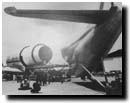 Loading airplanes this way has it's risks. During one trip to
Texas, a strong gust of wind picked up the tail, tumbling it down the tarmac
with the tail fixture still attached. A crew was summoned from California
to repair the damaged tail section.
Loading airplanes this way has it's risks. During one trip to
Texas, a strong gust of wind picked up the tail, tumbling it down the tarmac
with the tail fixture still attached. A crew was summoned from California
to repair the damaged tail section.(27K JPG image)
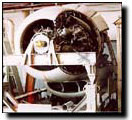 This is the famous Pratt & Whitney R-4360 28 cylinder radial
engine. At 3500 HP, one of the most powerful piston engines ever made. Also
called the "Corncob" because of the way all of those cylinders
looked. This wonder of engineering found it's way into many milestones of
aviation history, Boeing's B-50 bombers and Stratocruisers, Hughes' Hercules/Spruce
Goose, Vought/Goodyear F2G-1 (a modified F4U Corsair fitted with a R-4360
radial, cut-down aft fuselage and bubble canopy intended as a low-level
interceptor of Japanese suicide planes), Pregnant and Mini Guppys, as well
as many Reno racers.
This is the famous Pratt & Whitney R-4360 28 cylinder radial
engine. At 3500 HP, one of the most powerful piston engines ever made. Also
called the "Corncob" because of the way all of those cylinders
looked. This wonder of engineering found it's way into many milestones of
aviation history, Boeing's B-50 bombers and Stratocruisers, Hughes' Hercules/Spruce
Goose, Vought/Goodyear F2G-1 (a modified F4U Corsair fitted with a R-4360
radial, cut-down aft fuselage and bubble canopy intended as a low-level
interceptor of Japanese suicide planes), Pregnant and Mini Guppys, as well
as many Reno racers. (30K JPG image)
 In late 1962 the Pregnant Guppy was flown to NASA's Flight Test
Center at Edwards AFB, California for more intensive flight testing. This
testing continued into early 1963 with the only mishap being during the
water ballast testing the water system malfunctioned and flooded the floor
of the airplane. The pilot quickly landed with a very damp and irritated
test engineer in the Guppy's lower deck.
In late 1962 the Pregnant Guppy was flown to NASA's Flight Test
Center at Edwards AFB, California for more intensive flight testing. This
testing continued into early 1963 with the only mishap being during the
water ballast testing the water system malfunctioned and flooded the floor
of the airplane. The pilot quickly landed with a very damp and irritated
test engineer in the Guppy's lower deck. By this time NASA management began pushing for use of the Guppy as soon as possible with numerous letters and phone calls going to FAA officials. NASA was planning the first two-stage launch of the Saturn I vehicle, the SA-5. Because of time lost due to testing problems with the SA-5's first stage, time was becoming critical and the Guppy promised to fly the S-IV-5 stage to the Cape in eighteen hours as opposed to 18-25 days if shipped through the Panama Canal and Gulf of Mexico.
(26K JPG image)
 The Pregnant Guppy was declared a public aircraft on July 10,
1963. Military or government aircraft are usually public aircraft, and as
such are not subject to FAA regulations. In the Pregnant Guppy's case NASA
was the sponsoring government body attesting to it's airworthiness. MSFC
immediately conducted a transcontinental trial flight with a simulated S-IV
stage aboard. NASA relied on the Guppy in the late summer months and into
the fall. In mid-September the Guppy flew the S-IV-5 stage to Cape Kennedy
from Sacramento, California for the launch of the SA-5.
The Pregnant Guppy was declared a public aircraft on July 10,
1963. Military or government aircraft are usually public aircraft, and as
such are not subject to FAA regulations. In the Pregnant Guppy's case NASA
was the sponsoring government body attesting to it's airworthiness. MSFC
immediately conducted a transcontinental trial flight with a simulated S-IV
stage aboard. NASA relied on the Guppy in the late summer months and into
the fall. In mid-September the Guppy flew the S-IV-5 stage to Cape Kennedy
from Sacramento, California for the launch of the SA-5.(26K JPG image)
 While delivering the Apollo SM 009 on October 23 1965, the Pregnant
Guppy was delayed at Ellington Air Force Base, Texas, for three-and-a-half
days while waiting for an engine change. The incident was reviewed by NASA
officials during the succeeding weeks, and Aero Spacelines was requested
to place spare engines not only at Houston, but also at other strategic
locations on the normal air route from Long Beach, Calif., to Kennedy Space
Center, Florida in order to avoid this type of delay in the future
While delivering the Apollo SM 009 on October 23 1965, the Pregnant
Guppy was delayed at Ellington Air Force Base, Texas, for three-and-a-half
days while waiting for an engine change. The incident was reviewed by NASA
officials during the succeeding weeks, and Aero Spacelines was requested
to place spare engines not only at Houston, but also at other strategic
locations on the normal air route from Long Beach, Calif., to Kennedy Space
Center, Florida in order to avoid this type of delay in the futureBoth the LM test model TM-6 and test article LTA-10 were shipped from Grumman on the Pregnant Guppy. When the Pregnant Guppy carrying the LTA-10 stopped at Dover, Delaware on September 27, 1966 for refueling, a fire broke out inside the aircraft. Luckily it was discovered in time, preventing damage to the Guppy or the LM test article. Also note in this picture the addition of the chin radar dome.
(25K JPG image)
JATO-Guppy!
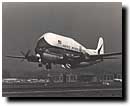
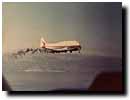 Our thanks to Karl Schneider for these great photos! Seen in the background
beneath the PG in the takeoff photo on the far left, is the Aero Spacelines'
hangers. The second photo shows the end of the burn at 8,000 feet! Karl
was on board the Pregnant Guppy for this series of JATO tests.
Our thanks to Karl Schneider for these great photos! Seen in the background
beneath the PG in the takeoff photo on the far left, is the Aero Spacelines'
hangers. The second photo shows the end of the burn at 8,000 feet! Karl
was on board the Pregnant Guppy for this series of JATO tests.He adds, "The burn out was a little more eventful than the takeoff. As the JATO bottles burned out, the flame licked back inside the lower aft compartment (the bottles were mounted inside the compartment) and set the zinc chromate primer on the skin of the lower belly on fire. It was not all that spectacular as onboard fires go and was easily put out with a hand held fire bottle. While determined as 'successful' we never used JATO for any 'in service' takeoffs."
Thanks again, Karl for the great story and pictures!
(48K & 23K JPG images)
 There is one more part of a B377 used in all Guppies that has
not been mentioned. It is the 46 section of the fuselage - the aft lower
part of the fuselage. In building Guppy No.4 for Airbus Industries there
were no remaining B377 fuselages to cannibalize, so ASI bought the 46 section
from the disassembled Pregnant Guppy and shipped it to France where it was
incorporated into SGT No.4. It is ironic that the last Guppy built contains
a part of the first Guppy built.
There is one more part of a B377 used in all Guppies that has
not been mentioned. It is the 46 section of the fuselage - the aft lower
part of the fuselage. In building Guppy No.4 for Airbus Industries there
were no remaining B377 fuselages to cannibalize, so ASI bought the 46 section
from the disassembled Pregnant Guppy and shipped it to France where it was
incorporated into SGT No.4. It is ironic that the last Guppy built contains
a part of the first Guppy built.(34K JPG image)


 Former ASI Pregnant Guppy Loadmaster Fred Austin sent us these photos. We're
not sure of the exact details, but the first photo (far left) appears to
be taken during the phase of construction after the inner fuselage had been
removed and the in the latter stages of adding the fuselage parting seam.
The second photo (center left) shows Jack Conroy with other members of the
crew standing in front of the Pregnant Guppy. The last photo shows an early
testing of the fuselage parting system.
Former ASI Pregnant Guppy Loadmaster Fred Austin sent us these photos. We're
not sure of the exact details, but the first photo (far left) appears to
be taken during the phase of construction after the inner fuselage had been
removed and the in the latter stages of adding the fuselage parting seam.
The second photo (center left) shows Jack Conroy with other members of the
crew standing in front of the Pregnant Guppy. The last photo shows an early
testing of the fuselage parting system.(62K, 80K & 68K JPG images)
Movies
 This is the updated "Morfing-Guppys" video. It shows the
size relationships between the original Stratocruiser and the various Guppys.
Seen here is the Pregnant, NASA Super, MGT, and SGT. For the best enjoyment
of this video after downloading; save it to your favorite directory and
then load into Media Player with the options set to "Repeat". Then sit back
and enjoy the show.
This is the updated "Morfing-Guppys" video. It shows the
size relationships between the original Stratocruiser and the various Guppys.
Seen here is the Pregnant, NASA Super, MGT, and SGT. For the best enjoyment
of this video after downloading; save it to your favorite directory and
then load into Media Player with the options set to "Repeat". Then sit back
and enjoy the show. (593K AVI video)
 The Pregnant Guppy carried cargo for 17 years. It was sold to
American Jet Industries (now Gulfstream American) in 1974. In 1979 the Pregnant
Guppy was cannibalized for parts and scrapped. With that, a unique part
of aviation history was lost forever, preserved now only in scarce photos
and movie clips.
The Pregnant Guppy carried cargo for 17 years. It was sold to
American Jet Industries (now Gulfstream American) in 1974. In 1979 the Pregnant
Guppy was cannibalized for parts and scrapped. With that, a unique part
of aviation history was lost forever, preserved now only in scarce photos
and movie clips. (425K QuickTime video)
Shortly after we posted the time lapse video, we received an email from Fred Austin, Pregnant Guppy Loadmaster for ASI from 1963-1965. In his email, Fred wrote, "In your latest addition to your web site you will notice that the tail goes back and forth a couple of times before it finally mates up. I believe those photos where taken at the FAA facility on Imperial Hwy at LAX. We were loading the boiler plate mockup of the Saturn S-4 Booster. It was the first time we had ever loaded cargo on the Guppy. And it was also the largest piece of air cargo ever loaded on an aircraft at that time.
"Everything went pretty well until we tried to line the tail back up with the airplane. Bill Cuffe, Aerospace Director of Maintenance was on the tug. This was the farthest we had ever had the tail from the airplane. Previously we had always just gone straight back and then straight ahead back to the airplane. To load the airplane we had pulled the tail off to the side to make room for the S-4 and it's trailer. There was less than and one inch clearance between the sides of the S-4's pallet and the rails inside the tail section.
"We finally got it lined up by castering the front wheels on the dolly. It was quite a show trying to look like we knew what we where doing, with no idea of what we were doing! We pulled it off and started the flight test program. The next time the tail came off we had a tiller on each of the dolly's front wheels and a guy guiding them. If you have any later photos of the Guppy being loaded you can see them.
"The other thing we learned was that all those dolly parts looked alike when they came out of the belly of the airplane we promptly color coded them. Left-hand-red, right-hand-green, the tail wheel dolly started natural aluminum."
Fred Austin
Loadmaster
Pregnant Guppy 1963-1965
Thanks Fred for the great story and our apologies for the tardiness in adding it.
Link here for Mac users having problems viewing movies. Use the Indeo Video 3.2 for Mac that installs Indeo version 3.22.24.09 for Mac 6.0.7 or later with QuickTime.
Comments or Questions? Email me
Copyright © 2006 Daren Savage
All Rights Reserved
